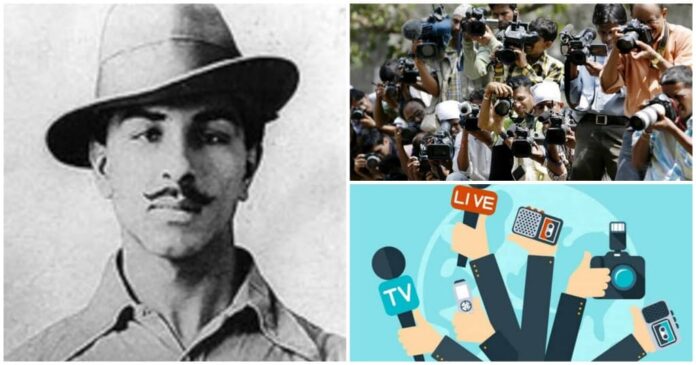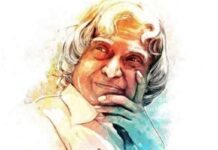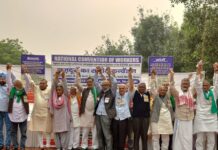At the age of 16-17, Bhagat Singh’s family wanted to get him married. But Bhagat Singh’s mind was set on other things, he wrote a letter to his father apologising for not fulfilling his wishes. In the letter he wrote that he has dedicated his life for the service of the country, hence a normal life and pleasures of life do not attract him.
Bhagat Singh came to Kanpur and joined another freedom fighter Ganesh Shankar Vidyarthi who used to publish ‘Pratap’ from Kanpur. Bhagat Singh would write under the pen name of Balwant Singh. His thought-provoking articles would be published in Pratap and it kindled the spark of revolution in readers’ minds. Bhagat Singh would also write for another paper from Kolkata called “Matwala”. His two articles became very famous from Matwala. One was called “Vishwaprem”( Love for the world) which was published in two sections. Bhagat Singh like other revolutionaries was also writing under a pen name.

Bhagat Singh’s journalism bloomed in Pratap. In the beginning, even Ganesh Shankar Vidyarthi did not know who is Balwant Singh. When he got to know, he hugged Bhagat Singh and Bhagat Singh became part of the editorial team. Around the same time, riots broke out in Delhi, Vidyarthi sent Bhagat Singh to cover the riots. Vidyarthi wanted unbiased reporting and Bhagat Singh did not disappoint him. While working with Pratap, Bhagat Singh translated the autobiography of the great revolutionary Shachidranath Sanyal’s’ Bandi ki Jeevani‘ (life of a prisoner) in Punjabi. This translation brought a new wave in Punjab. He also translated the autobiography of Irish revolutionary Dan Breen’s “My Fight for Irish Freedom’ into Hindi. The article gave an ideological turn to the ongoing freedom movement in the country.
Vidyarthi was very proud of Bhagat Singh and he introduced him to the leader of all revolutionaries at that time- Chandrashekhar Azad. This was the wonderful and passionate meeting of the two freedom lovers.
Bhagat Singh was doing excellent work in revolutionary and journalistic activities. This did not escape the police’s eye and the secret service was intensified. To save him from the police, Vidyarthi sent him to Shadipur village of Aligarh district as a headmaster. During this time Vidyarthi got to know about Bhagat Singh’s family condition and about the illness of his grandmother. Vidyarthi went to Shadipur himself and convinced him to go home. After his visit home, Bhagat Singh returned to Delhi and started working with Dainik Veer Arjun and soon he came to be known as a sharp reporter and a thoughtful writer.
Who is afraid of a Living Bhagat Singh?
Along with Veer Arjun, Bhagat Singh also started writing for the Punjabi magazine Kirti. He used to write under the pen name of Vidrohi. He also used to write for another Delhi journal named Maharathi. He continued to be in touch with Vidyarthi and would write for Pratap. Bhagat Singh wrote an explosive article for Pratap on 15th March 1926. The article was titled- Holi ke din Rakt ke chhinte (Blood splatter on Holi).
Civil Disobedience is at its peak. Punjab is ahead of everyone. Sikhs are rising in Punjab. There is a lot of passion. The Akali movement has started. Sacrifices are flowing.
Bhagat Singh wrote an article in the pen name of Vidrohi saluting the soldiers of the Kakori case. He writes-
We sigh and we think our duty is done. We don’t feel the fire. We don’t yearn. We are so dead inside. They are on a hunger strike. They are in pain and we are just watching. May God gives them strength and they finish their time in jail and their sacrifice is worthwhile.
This article was published in January 1928 in Kirti. Bhagat Singh wrote prolifically for the next three years. He had a great impact on people’s minds through his writings.
In Feb 1928, he wrote an article on Kuka rebels under the name of BS Sandhu. He described how 66 Kuka rebels were tied to the tanks and blown away. The title of the article was- Yug Palatne Wala Agnikund (Firepit that changed the period).
From March to October 1928 he wrote a series titled- Aazadi ki bhent Shahadatein (Martyrs at the Altar of Freedom). In this Bhagat Singh wrote stories of the revolutionaries who sacrificed their lives. One of the stories was on Madan Lal Dhingra. How Bhagat Singh weaved words was extraordinary. He wrote-
Madan Lal was standing next to the noose and he was asked for his last words. He said- Vande Mataram. Salute to Bharat Maa! His body was buried in the jail itself. We Indians don’t even get to cremate him. Blessed be that Brave. Blessed is his memory. Many many salutes to the precious Hero of this dead country.
 This was the golden age of his Journalism. His articles and reports were becoming famous in India. His writing became even more prolific when he went to jail. He wrote one article- Punjab ka Pehla Ubhaar (The first Upheaval of Punjab) for a Lahore-based Weekly called ‘Vande Mataram‘ from jail. From May to September 1928, Kirti serialised Bhagat Singh’s article on Anarchism. In this series, Bhagat Singh attacked the thinking of the status quoists of the country.
This was the golden age of his Journalism. His articles and reports were becoming famous in India. His writing became even more prolific when he went to jail. He wrote one article- Punjab ka Pehla Ubhaar (The first Upheaval of Punjab) for a Lahore-based Weekly called ‘Vande Mataram‘ from jail. From May to September 1928, Kirti serialised Bhagat Singh’s article on Anarchism. In this series, Bhagat Singh attacked the thinking of the status quoists of the country.
Nowadays the problems of Dalits and religious conversions are making headlines. Bhagat Singh had written on this issue 87 years ago. He wrote-
“When you treat them worse than animals, they will definitely convert to other religions. They will get more rights in those religions. They will be treated as humans. Then it will be useless to say that Christians and Muslims are harming the Hindu community.
This accuracy of Bhagat Singh’s comment is shocking.
A similar comment of his-
“ultimately the problem cannot be satisfactorily solved unless and until (so-called)untouchables communities themselves unite and organise….we regard their recent uniting based on their distinct identity…as a move in the right direction…we plead that they (the so called-untouchables) must persist in pressing for their own distinct representation in legislatures in proportion to their numerical strength…without your own efforts, you shall not be able to move ahead”.
You are the real working class…Arise and rebel against the existing order. Gradualism and reformism shall be of no avail to you. Start a revolution from a social agitation and gird up your loins for political and economic revolution. You and you alone are pillars of the nation and its core strength. Awake, O sleeping lions! Rebel, raise the banner of revolt”.
Only Bhagat Singh could have dared to write like this. The historical edition of ‘Chand’ magazine that was banned by the British had many articles by Bhagat Singh. This edition is considered the Gita of Indian Journalism.
In the end, the pamphlet which shook the British government. The pamphlets distributed on 8th April 1929 in the assembly bomb incident were written by Bhagat Singh.
On the pamphlet was written the now-famous quote –
“If the deaf are to hear, the sound has to be very loud.”
“Let the representatives of the people return to their constituencies and prepare the masses for the coming revolution and let the Government know that while protesting against the Public Safety and Trade Disputes Bills and the callous murder of Lala Lajpat Rai, on behalf of the helpless Indian masses, we want to emphasize the lesson often repeated by history, that it is easy to kill individuals but you cannot kill the ideas.Great empires crumbled while the ideas survived. Bourbons and Czars fell. While the revaluation marched ahead triumphantly.”
The article was published in hindi on janjwar.com.It is translated into English by Swati S. Views expressed are Personal.




























[…] Journalists Have a Lot to Learn From Bhagat Singh […]